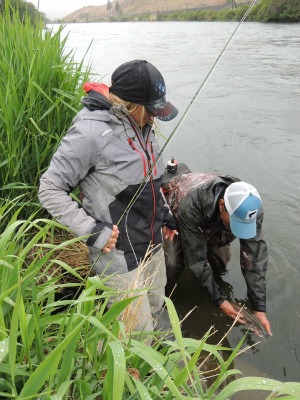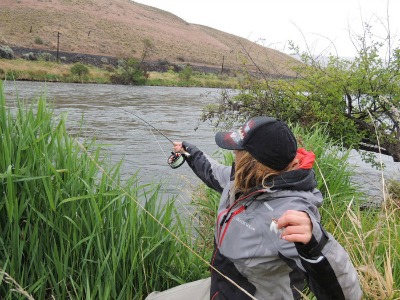When the Trout are Tight to the Bank
By Gary Lewis
 If she’d ever had a casting lesson, she didn’t admit to it.
If she’d ever had a casting lesson, she didn’t admit to it.When a fly-fishing guide wants to teach, it’s best to soak it in. Kristy Titus was smart enough to listen and she learned the easy pick-up-and-lay-down basic fly cast. When the guide was finished, I completed the lesson with a session on the hook-set.
Elke Littleleaf Kirk is a Warm Springs guide, a self-taught fly-fisherman and fly tier. He and his wife, Alysia, own Littleleaf Guide Service and this year, for the first time, after a couple of years in business, they are booked solid through the salmonfly hatch on the Deschutes.
Kristy is from Central Oregon. She is a bowhunter, she packs into the backcountry on her mules, she hunts bear, deer and elk. Walk into a Cabela’s store anywhere and you are likely to walk past her cardboard life-sized likeness.
She knew enough about fly-fishing to know a dry fly from a wet fly, but she had never caught a fish on a fly rod. She had no idea what we were talking about when we talked about the salmonfly hatch.
There are actually two big bugs – the salmonfly, orange and charcoal, about two inches long, and the golden stonefly, which is usually a bit shorter. When the water warms, when the sunlight penetrates the water in the spring, when the days grow longer, usually in mid- to late May, the nymphs begin to migrate shoreward.
They crawl out of the water and into the grass to dry their wings. And the trout are watching. Even the biggest rainbows pull in close to the bank to feed on the bounty. There is no other time of the year when a person can float a big bushy dry fly two feet off the bank and expect to get it pounded by a big Deschutes redside. It is world-class dry fly fishing on one of the world’s greatest rivers.
Like I’ve been telling you since February, it all starts earlier this year. Anglers were getting grabs on top, on big salmonflies, the first week of May.

Alysia couldn’t drift with us on this day, but she sent some flies, including a Predator salmonfly pattern that was the very first one she had ever tied. She wanted Kristy to fish it.
After several days of warm, clear weather, our morning dawned with unfriendly clouds. We put in the water above the mouth of the Warm Springs River. The long grasses were packed with golden stones and salmonflies. Since there were more golden stones, I tied on a foam-body, iridescent dubbed, calf-winged golden with beady red eyes.
We started in a little side channel around an island, river left. Kristy plied the lay-down cast and on her third attempt, a trout went for it. One of them missed, let’s blame it on the fish, and then one of them missed again.
The rain began, it started with a few drops then built in intensity, and it hit in big drops that made little splashes. There were no stoneflies on the water, but that was because as soon as a bug hit the surface, a fish was on it.
My fly splashed down on the edge of a seam and I threw a mend to keep the line from dragging the bug. There was a splash and I set the hook into a 17-incher.
When the big rainbows are feeding in close, it doesn’t require a long cast. We drifted down, tied up to a tree and stalked along the bank. The fish had been eating salmonflies on top for a week before we got to them. They weren’t as big around as footballs, but they will be by June. Another 18-incher tumbled to my temptation and we admired it for a moment and let it go.

Kristy’s inner hunter overpowered her newbie fishing self. “Try the bow-and-arrow cast,” Elke said, and he demonstrated. He pulled the line and leader taut about nine feet out of the tip, till there was a bow in the upper section of the rod. He let the fly go and it lit upon the water. He let Kristy try it.
You could hear her shout all the way to the Mutton Mountains. This fish was hooked – maybe 13 inches – and it stayed hooked, on the fly Alysia had tied. The bowhunter brought her first fish to hand on a bow-and-arrow cast. Dry fly fishing is about belief – a fish is there, it is looking up, we chose the right day and the right pattern.
By the end of the afternoon, Kristy could cast 30 feet and tell a salmonfly from a golden stone. When we climbed into the boat that morning, she started at zero, but she had instructors and she learned from the river, the best teacher.
We drifted down and the rain was steady, but so was the fishing. It might be hard to time the salmonfly hatch, but on the Deschutes when the big bugs are in the grass and the trout are tight to the bank, there are no bad days.
Gary Lewis is the host of Frontier Unlimited TV and author of John Nosler – Going Ballistic, A Bear Hunter's Guide to the Universe, Hunting Oregon and other titles. Contact Gary at www.GaryLewisOutdoors.com.
The End


